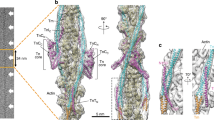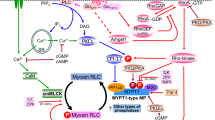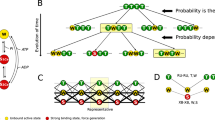Abstract
THE regulation of contractile activity in cardiac muscle by changes in the intracellular Ca2+ concentration involves the regulatory protein system, consisting of tropomyosin and the troponin complex that is located in the I filament. Although the regulatory protein system of cardiac muscle is essentially similar in function to that of skeletal muscle, the components differ in the two tissues. Cardiac tropomyosin consists principally of α subunits, whereas the skeletal protein is composed of α and β subunits1. Troponin I, troponin C and troponin T are all specific for cardiac muscle in that they have different chemical and immunochemical properties from the corresponding skeletal muscle proteins2–4. In addition, cardiac troponin I and cardiac troponin C have been shown to have different amino acid sequences from their skeletal muscle counterparts3,5.
This is a preview of subscription content, access via your institution
Access options
Subscribe to this journal
Receive 51 print issues and online access
$199.00 per year
only $3.90 per issue
Buy this article
- Purchase on Springer Link
- Instant access to full article PDF
Prices may be subject to local taxes which are calculated during checkout
Similar content being viewed by others
References
Cummins, P., and Perry, S. V., Biochem. J., 141, 43–49 (1974).
Hirabayashi, T., and Perry, S. V., Biochim. biophys. Acta, 351, 273–389 (1973).
Grand, R. J. A., Wilkinson, J. M., and Mole, L. E., Biochem. J. (in the press).
Cole, H. A., and Perry, S. V., Biochem. J., 149, 525–533 (1975).
Van Eerd, J. P., and Takahashi, K., Biochemistry, 15, 1171–1180 (1976).
England, P., FEBS Lett., 50, 57–60 (1975).
Syska, H., Perry, S. V., and Trayler, I. P., FEBS Lett., 40, 253–257 (1974).
Neely, J. R., Leibermeister, H., Battersby, E. J., and Morgan, H. E., Am. J. Physiol., 212, 804–814 (1967).
Krebs, H. A., and Henseleit, K., Z. physicol. Chem., 210, 33–66 (1932).
Morgan, H. E., Henderson, M. J., Regen, D. M., and Park, C. R., J. Biol. Chem., 236, 253–261 (1961).
Moir, A. J. G., Wilkinson, J. M., and Perry, S. V., FEBS Lett., 42, 253–256 (1974).
Huang, T. S., Bylund, D. B., Stull, J. T., and Krebs, E. G., FEBS Lett., 42, 249–252 (1974).
Syska, H., Wilkinson, J. M., Grand, R. J. A., and Perry, S. V., Biochem. J., 153, 375–387 (1976).
Rubio, R., Bailey, C., and Villar-Palasi, C., J. Cyclic Nucleotide Res., 1, 143–150 (1975).
Perry, S. V., and Cole, H. A., Biochem. J., 141, 733–743 (1974).
Author information
Authors and Affiliations
Rights and permissions
About this article
Cite this article
SOLARO, R., MOIR, A. & PERRY, S. Phosphorylation of troponin I and the inotropic effect of adrenaline in the perfused rabbit heart. Nature 262, 615–617 (1976). https://doi.org/10.1038/262615a0
Received:
Accepted:
Issue Date:
DOI: https://doi.org/10.1038/262615a0
This article is cited by
-
Regulation of myocardial contraction as revealed by intracellular Ca2+ measurements using aequorin
The Journal of Physiological Sciences (2024)
-
Recent studies of the molecular mechanism of lusitropy due to phosphorylation of cardiac troponin I by protein kinase A
Journal of Muscle Research and Cell Motility (2023)
-
Role of Ca2+ in healthy and pathologic cardiac function: from normal excitation–contraction coupling to mutations that cause inherited arrhythmia
Archives of Toxicology (2023)
-
Truncation of the N-terminus of cardiac troponin I initiates adaptive remodeling of the myocardial proteosome via phosphorylation of mechano-sensitive signaling pathways
Molecular and Cellular Biochemistry (2022)
-
Evolution of the N-Terminal Regulation of Cardiac Troponin I for Heart Function of Tetrapods: Lungfish Presents an Example of the Emergence of Novel Submolecular Structure to Lead the Capacity of Adaptation
Journal of Molecular Evolution (2022)
Comments
By submitting a comment you agree to abide by our Terms and Community Guidelines. If you find something abusive or that does not comply with our terms or guidelines please flag it as inappropriate.



